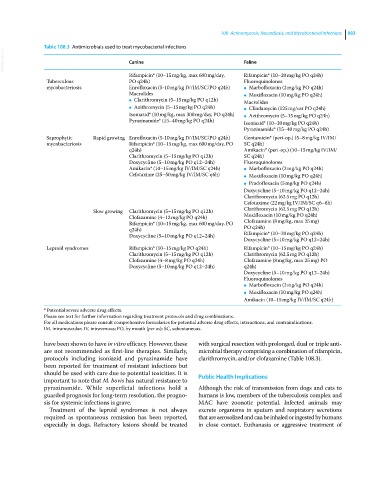Page 1045 - Clinical Small Animal Internal Medicine
P. 1045
108 Actinomycosis, Nocardiosis, and Mycobacterial Infections 983
Table 108.3 Antimicrobials used to treat mycobacterial infections
VetBooks.ir Canine Feline
Rifampicin* (10–15 mg/kg, max 600 mg/day, Rifampicin* (10–20 mg/kg PO q24h)
Tuberculous PO q24h) Fluoroquinolones
mycobacteriosis Enrofloxacin (5-10 mg/kg IV/IM/SC/PO q24h) ● Marbofloxacin (2 mg/kg PO q24h)
Macrolides ● Moxifloxacin (10 mg/kg PO q24h)
● Clarithromycin (5–15 mg/kg PO q12h) Macrolides
● Azithromycin (5–15 mg/kg PO q24h) ● Clindamycin (125 mg/cat PO q24h)
Isoniazid* (10 mg/kg, max 300 mg/day, PO q24h) ● Azithromycin (5–15 mg/kg PO q24h)
Pyrazinamide* (15–40 mg/kg PO q24h) Isoniazid* (10–20 mg/kg PO q24h)
Pyrazinamide* (15–40 mg/kg PO q24h)
Saprophytic Rapid growing Enrofloxacin (5-10 mg/kg IV/IM/SC/PO q24h) Gentamicin* (peri‐op.) (5–8 mg/kg IV/IM/
mycobacteriosis Rifampicin* (10–15 mg/kg, max 600 mg/day, PO SC q24h)
q24h) Amikacin* (peri‐op.) (10–15 mg/kg IV/IM/
Clarithromycin (5–15 mg/kg PO q12h) SC q24h)
Doxycycline (5–10 mg/kg PO q12–24h) Fluoroquinolones
Amikacin* (10–15 mg/kg IV/IM/SC q24h) ● Marbofloxacin (2 mg/kg PO q24h)
Cefotaxime (25–50 mg/kg IV/IM/SC q6h) ● Moxifloxacin (10 mg/kg PO q24h)
Pradofloxacin (5 mg/kg PO q24h)
●
Doxycycline (5–10 mg/kg PO q12–24h)
Clarithromycin (62.5 mg PO q12h)
Cefotaxime (22 mg/kg IV/IM/SC q6–8h)
Slow growing Clarithromycin (5–15 mg/kg PO q12h) Clarithromycin (62.5 mg PO q12h)
Clofazamine (4–12 mg/kg PO q24h) Moxifloxacin (10 mg/kg PO q24h)
Rifampicin* (10–15 mg/kg, max 600 mg/day, PO Clofazamine (8 mg/kg, max 25 mg)
q24h) PO q24h)
Doxycycline (5–10 mg/kg PO q12–24h) Rifampicin* (10–20 mg/kg PO q24h)
Doxycycline (5–10 mg/kg PO q12–24h)
Leproid syndromes Rifampicin* (10–15 mg/kg PO q24h) Rifampicin* (10–15 mg/kg PO q24h)
Clarithromycin (5–15 mg/kg PO q12h) Clarithromycin (62.5 mg PO q12h)
Clofazamine (4–8 mg/kg PO q24h) Clofazamine (8 mg/kg, max 25 mg) PO
Doxycycline (5–10 mg/kg PO q12–24h) q24h)
Doxycycline (5–10 mg/kg PO q12–24h)
Fluoroquinolones
● Marbofloxacin (2 mg/kg PO q24h)
● Moxifloxacin (10 mg/kg PO q24h)
Amikacin (10–15 mg/kg IV/IM/SC q24h)
* Potential severe adverse drug effects.
Please see text for further information regarding treatment protocols and drug combinations.
For all medications please consult comprehensive formularies for potential adverse drug effects, interactions, and contraindications.
IM, intramuscular; IV, intravenous; PO, by mouth (per os); SC, subcutaneous.
have been shown to have in vitro efficacy. However, these with surgical resection with prolonged, dual or triple anti-
are not recommended as first‐line therapies. Similarly, microbial therapy comprising a combination of rifampicin,
protocols including isoniazid and pyrazinamide have clarithromycin, and/or clofazamine (Table 108.3).
been reported for treatment of resistant infections but
should be used with care due to potential toxicities. It is Public Health Implications
important to note that M. bovis has natural resistance to
pyrazinamide. While superficial infections hold a Although the risk of transmission from dogs and cats to
guarded prognosis for long‐term resolution, the progno- humans is low, members of the tuberculosis complex and
sis for systemic infections is grave. MAC have zoonotic potential. Infected animals may
Treatment of the leproid syndromes is not always excrete organisms in sputum and respiratory secretions
required as spontaneous remission has been reported, that are aerosolized and can be inhaled or ingested by humans
especially in dogs. Refractory lesions should be treated in close contact. Euthanasia or aggressive treatment of

